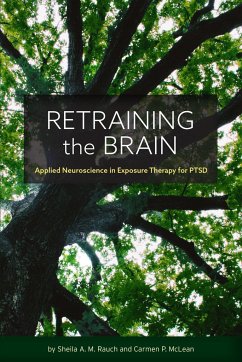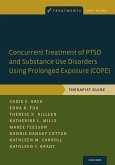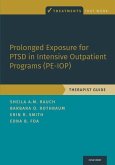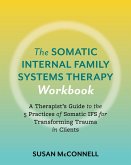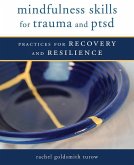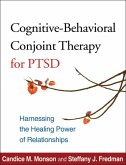- Broschiertes Buch
- Merkliste
- Auf die Merkliste
- Bewerten Bewerten
- Teilen
- Produkt teilen
- Produkterinnerung
- Produkterinnerung
A clinician-driven, research-based review of the theory and applicable neuroscience informing prolonged exposure therapy, a cognitive behavioral approach designed specifically for PTSD patients to reduce pathological anxiety and related emotions.
Andere Kunden interessierten sich auch für
![Concurrent Treatment of Ptsd and Substance Use Disorders Using Prolonged Exposure (Cope) Concurrent Treatment of Ptsd and Substance Use Disorders Using Prolonged Exposure (Cope)]() Sudie E BackConcurrent Treatment of Ptsd and Substance Use Disorders Using Prolonged Exposure (Cope)86,99 €
Sudie E BackConcurrent Treatment of Ptsd and Substance Use Disorders Using Prolonged Exposure (Cope)86,99 €![Treating Ptsd in First Responders Treating Ptsd in First Responders]() Richard A BryantTreating Ptsd in First Responders43,99 €
Richard A BryantTreating Ptsd in First Responders43,99 €![Prolonged Exposure for Ptsd in Intensive Outpatient Programs (Pe-Iop) Prolonged Exposure for Ptsd in Intensive Outpatient Programs (Pe-Iop)]() Sheila A. M. RauchProlonged Exposure for Ptsd in Intensive Outpatient Programs (Pe-Iop)53,99 €
Sheila A. M. RauchProlonged Exposure for Ptsd in Intensive Outpatient Programs (Pe-Iop)53,99 €![The Somatic Internal Family Systems Therapy Workbook The Somatic Internal Family Systems Therapy Workbook]() Susan McconnellThe Somatic Internal Family Systems Therapy Workbook17,99 €
Susan McconnellThe Somatic Internal Family Systems Therapy Workbook17,99 €![Mindfulness Skills for Trauma and Ptsd: Practices for Recovery and Resilience Mindfulness Skills for Trauma and Ptsd: Practices for Recovery and Resilience]() Rachel Goldsmith TurowMindfulness Skills for Trauma and Ptsd: Practices for Recovery and Resilience22,99 €
Rachel Goldsmith TurowMindfulness Skills for Trauma and Ptsd: Practices for Recovery and Resilience22,99 €![An EMDR Therapy Primer An EMDR Therapy Primer]() Barbara J HensleyAn EMDR Therapy Primer71,99 €
Barbara J HensleyAn EMDR Therapy Primer71,99 €![Cognitive-Behavioral Conjoint Therapy for Ptsd Cognitive-Behavioral Conjoint Therapy for Ptsd]() Candice M MonsonCognitive-Behavioral Conjoint Therapy for Ptsd44,99 €
Candice M MonsonCognitive-Behavioral Conjoint Therapy for Ptsd44,99 €-
-
-
A clinician-driven, research-based review of the theory and applicable neuroscience informing prolonged exposure therapy, a cognitive behavioral approach designed specifically for PTSD patients to reduce pathological anxiety and related emotions.
Produktdetails
- Produktdetails
- Verlag: American Psychological Association (APA)
- Seitenzahl: 219
- Erscheinungstermin: 11. Mai 2021
- Englisch
- Abmessung: 229mm x 152mm x 10mm
- Gewicht: 272g
- ISBN-13: 9781433834042
- ISBN-10: 1433834049
- Artikelnr.: 60584132
- Herstellerkennzeichnung
- Libri GmbH
- Europaallee 1
- 36244 Bad Hersfeld
- gpsr@libri.de
- Verlag: American Psychological Association (APA)
- Seitenzahl: 219
- Erscheinungstermin: 11. Mai 2021
- Englisch
- Abmessung: 229mm x 152mm x 10mm
- Gewicht: 272g
- ISBN-13: 9781433834042
- ISBN-10: 1433834049
- Artikelnr.: 60584132
- Herstellerkennzeichnung
- Libri GmbH
- Europaallee 1
- 36244 Bad Hersfeld
- gpsr@libri.de
Sheila A. M. Rauch, PhD, ABPP, is a professor in the Department of Psychiatry and Behavioral Sciences at the Emory University School of Medicine and serves as deputy director of the Emory Healthcare Veterans Program and director of mental health research and program evaluation at the VA Atlanta Healthcare System. She has been developing programs, conducting research, and providing treatment for PTSD and anxiety disorders for over 2 years. She has published scholarly articles, chapters, and books on anxiety disorders and PTSD, focusing on neurobiology and factors involved in the development, maintenance, and treatment of anxiety disorders. Carmen P. McLean, PhD, is a clinical psychologist at the National Center for PTSD amp rsquo s Dissemination and Training Division at the Palo Alto VA and a clinical associate professor (affiliate) at Stanford University. She amp rsquo s an associate editor for Cognitive Behavioral Practice and a 2 8 recipient of the Anne Marie Albano Early Career Award for Excellence in the Integration of Science and Practice from the Association for Cognitive and Behavioral Therapies. She amp rsquo s published over articles and chapters on PTSD and anxiety. Her research examines ways to increase the reach of exposure therapy for PTSD by addressing implementation barriers and testing eHealth interventions.
Preface
I. Overview of Prolonged Exposure and Theory
Chapter 1. Theory and Prolonged Exposure
Chapter 2. What Is Prolonged Exposure Therapy?
II. Neuroscience Methods for Clinicians
Chapter 3. Neurosteroids, Cortisol, and Other Neurochemicals
Chapter 4. Imaging
Chapter 5. Electroencephalography
Chapter 6. Psychophysiology
Chapter 7. Genetics and Genomics
III. Applied Neuroscience: Prolonged Exposure for PTSD
Chapter 8. Psychoeducation and Neuroscience
Chapter 9. In Vivo Exposure and Neuroscience
Chapter 10. Imaginal Exposure and Neuroscience
Chapter 11. Processing and Neuroscience
IV. Future Directions
Chapter 12. Augmentation of Prolonged Exposure
Chapter 13. New Models of Care Delivery
References
Glossary
I. Overview of Prolonged Exposure and Theory
Chapter 1. Theory and Prolonged Exposure
Chapter 2. What Is Prolonged Exposure Therapy?
II. Neuroscience Methods for Clinicians
Chapter 3. Neurosteroids, Cortisol, and Other Neurochemicals
Chapter 4. Imaging
Chapter 5. Electroencephalography
Chapter 6. Psychophysiology
Chapter 7. Genetics and Genomics
III. Applied Neuroscience: Prolonged Exposure for PTSD
Chapter 8. Psychoeducation and Neuroscience
Chapter 9. In Vivo Exposure and Neuroscience
Chapter 10. Imaginal Exposure and Neuroscience
Chapter 11. Processing and Neuroscience
IV. Future Directions
Chapter 12. Augmentation of Prolonged Exposure
Chapter 13. New Models of Care Delivery
References
Glossary
Preface
I. Overview of Prolonged Exposure and Theory
Chapter 1. Theory and Prolonged Exposure
Chapter 2. What Is Prolonged Exposure Therapy?
II. Neuroscience Methods for Clinicians
Chapter 3. Neurosteroids, Cortisol, and Other Neurochemicals
Chapter 4. Imaging
Chapter 5. Electroencephalography
Chapter 6. Psychophysiology
Chapter 7. Genetics and Genomics
III. Applied Neuroscience: Prolonged Exposure for PTSD
Chapter 8. Psychoeducation and Neuroscience
Chapter 9. In Vivo Exposure and Neuroscience
Chapter 10. Imaginal Exposure and Neuroscience
Chapter 11. Processing and Neuroscience
IV. Future Directions
Chapter 12. Augmentation of Prolonged Exposure
Chapter 13. New Models of Care Delivery
References
Glossary
I. Overview of Prolonged Exposure and Theory
Chapter 1. Theory and Prolonged Exposure
Chapter 2. What Is Prolonged Exposure Therapy?
II. Neuroscience Methods for Clinicians
Chapter 3. Neurosteroids, Cortisol, and Other Neurochemicals
Chapter 4. Imaging
Chapter 5. Electroencephalography
Chapter 6. Psychophysiology
Chapter 7. Genetics and Genomics
III. Applied Neuroscience: Prolonged Exposure for PTSD
Chapter 8. Psychoeducation and Neuroscience
Chapter 9. In Vivo Exposure and Neuroscience
Chapter 10. Imaginal Exposure and Neuroscience
Chapter 11. Processing and Neuroscience
IV. Future Directions
Chapter 12. Augmentation of Prolonged Exposure
Chapter 13. New Models of Care Delivery
References
Glossary

